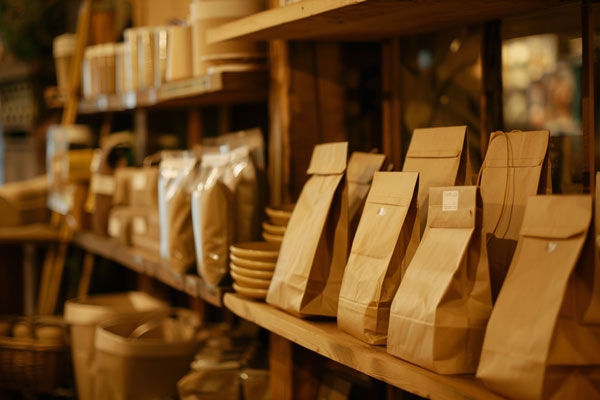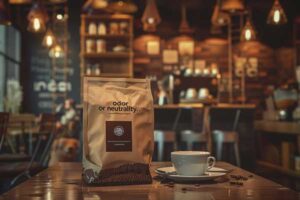In the food packaging industry, ensuring that paper containers are safe, durable, and effective in preserving the quality of food is paramount. Various types of coatings are applied to paper-based food-grade containers to enhance their performance. This article explores the different types of coatings used, their applications, and how they contribute to the effectiveness of food packaging.
Types of Food-Grade Coatings for Paper Containers
Wax Coating
Wax coatings have long been used in food packaging due to their excellent moisture resistance. The wax creates a barrier that prevents liquids from penetrating the paper, making it ideal for packaging items like baked goods and confectioneries. Wax-coated paper containers are also commonly used for wrapping sandwiches, as they provide a layer of protection that keeps the food fresh.
Applications:
Wax-coated containers are suitable for short-term food storage and packaging where the primary concern is moisture resistance. However, they are less environmentally friendly compared to other modern alternatives.
Polyethylene (PE) Coating
Polyethylene (PE) coatings are widely used in the food packaging industry due to their strong moisture and grease resistance. PE is a type of plastic that provides a protective layer on paper containers, making them suitable for holding both hot and cold foods. The material’s durability ensures that the container maintains its integrity during use.
Advantages:
PE coatings are particularly valued for their ability to protect food from external contaminants while maintaining the container’s strength. This makes them a popular choice for disposable coffee cups, takeout boxes, and other food containers that require reliable protection against moisture and grease.
Biodegradable Coating
With the growing demand for environmentally friendly packaging, biodegradable coatings have become increasingly popular. These coatings are made from bio-based materials that decompose naturally over time, reducing environmental impact. Biodegradable coatings offer similar protective qualities as traditional coatings but with the added benefit of being eco-friendly.
Environmental Significance:
Biodegradable coatings are an excellent option for brands looking to reduce their carbon footprint and appeal to eco-conscious consumers. For more information on how biodegradable coatings contribute to sustainability, visit SENDA’s Biodegradable Coating Solutions.
Water-Based Coating
Water-based coatings are made from water-soluble materials that are safe for food contact. These coatings are applied to paper containers to enhance their resistance to moisture and grease without the use of harmful chemicals. Water-based coatings are an excellent choice for food packaging as they are non-toxic and environmentally friendly.
Applications:
Water-based coatings are often used in the production of paper cups, trays, and other food containers that require a safe and effective barrier against liquids and oils. They provide the necessary protection while being safer for the environment compared to solvent-based coatings.
Applications of Food-Grade Coatings in Paper Containers
Takeout and Fast Food Packaging
Paper containers are widely used in takeout and fast food packaging due to their convenience and cost-effectiveness. Coatings such as PE and wax play a crucial role in protecting the food from external factors, ensuring that it remains fresh and safe for consumption. The coatings prevent the packaging from becoming soggy and help maintain the quality of the food during transport.
Food Storage and Transportation
During long-distance transportation, food-grade coatings on paper containers are essential in protecting the contents from moisture, contamination, and physical damage. Wax and PE coatings provide a strong barrier that ensures the food remains in good condition, even during extended storage periods.
Frozen Food Packaging
Paper containers used for frozen foods require coatings that can withstand low temperatures without cracking or degrading. PE coatings are particularly effective in these scenarios, as they offer the necessary durability and moisture resistance to protect the food from freezer burn and other damage.
Performance Characteristics of Food-Grade Coatings
Water and Oil Resistance
One of the most critical functions of food-grade coatings is to prevent liquids and oils from penetrating the paper container. Coatings like PE and wax excel in this regard, ensuring that the container remains intact and that the food stays fresh.
Heat-Sealability
The ability to securely seal a container is vital for maintaining food safety and freshness. Coatings that enhance heat-sealability, such as specific water-based and PE coatings, allow for airtight seals that prevent leakage and contamination. This is especially important for containers used in takeout packaging and food delivery services. Learn more about heat-sealable coatings and their benefits here.
Chemical Resistance
Food-grade coatings must also be resistant to various food substances, including acidic, alkaline, and fatty components. Coatings like PE provide excellent chemical resistance, ensuring that the container does not degrade or react negatively when in contact with certain food items.
Conclusion
Food-grade coatings for paper containers are essential in ensuring that food packaging is safe, effective, and environmentally friendly. From traditional wax coatings to modern biodegradable and water-based options, each type offers unique benefits that cater to different packaging needs. Understanding the applications and performance characteristics of these coatings can help manufacturers choose the right solution for their products, ensuring the safety and satisfaction of their customers.




